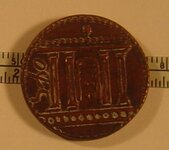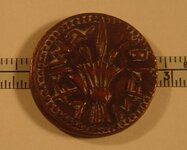B
BIG61AL
Guest
Greek coin - can't id, need help
Found this in an antique mall for a buck. I knew it was real old the second I saw and they did not know what they had. 26mm across, 2.5 mm thick Copper or bronze. Don't have exact weight...as heavy as a us half dollar. I am guessing the letters are Greek but i can only confirm a few. Has a lovely light green patina on the deeper parts of the surface...I've tried to look this up in the library and on the net but they always focus on silver coins and portrait coins. I get the impression this a more common coin used for in country circulation as opposed to internation trading. I don't think this goes as far back to the classical period but my personal best guess is ...1000 AD to 1500 AD. My challenge to all of you....confirm or deny.
Found this in an antique mall for a buck. I knew it was real old the second I saw and they did not know what they had. 26mm across, 2.5 mm thick Copper or bronze. Don't have exact weight...as heavy as a us half dollar. I am guessing the letters are Greek but i can only confirm a few. Has a lovely light green patina on the deeper parts of the surface...I've tried to look this up in the library and on the net but they always focus on silver coins and portrait coins. I get the impression this a more common coin used for in country circulation as opposed to internation trading. I don't think this goes as far back to the classical period but my personal best guess is ...1000 AD to 1500 AD. My challenge to all of you....confirm or deny.








